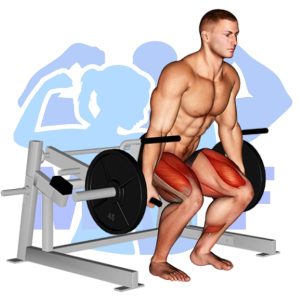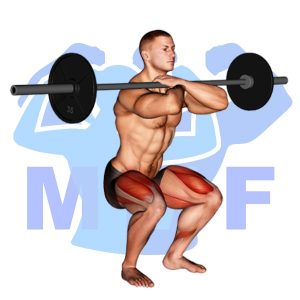Are you struggling with the Smith deadlift? Don’t worry, you’re not alone. It’s a common problem for many gym-goers who are trying to master this lift. The reason for this struggle is often due to poor form or a lack of understanding of the proper technique. But don’t sweat it, there are solutions that can help you improve your form and get the most out of this lift. In this post, we’ll cover some of the common mistakes made during the Smith deadlift and provide tips on how to fix them, so you can get back to crushing your workouts with confidence.
Smith Machine Deadlift Summary
- Primary Muscles: Gluteus Maximus
- Secondary Muscles: Adductor Magnus, Quadriceps, and Soleus
- Equipment: Smith Machine
- Mechanics Type: Compound
- Force: Pull
- Utility: Basic

Smith Machine Deadlift Instructions
- Place the barbell on the Smith Machine at a comfortable height.
- Position yourself in front of the barbell with your feet shoulder width apart.
- Bend down to grip the barbell with an overhand grip.
- Engage your core and keep your back straight.
- Drive your feet into the floor and use your legs to lift the weight up, pushing your hips forward.
- Once you have reached full extension, slowly lower the barbell back down to the start position.
- Repeat as desired.
Video Tutorial
Smith Machine Deadlift Muscles
Target (Agonist)
Synergists
- Adductor Magnus
- Quadriceps
- Sartorius
- Soleus
Dynamic Stabilizers
Stabilizers
- Erector Spinae
- Levator Scapulae
- Sartorius
- Rhomboids
- Trapezius – Middle
- Trapezius – Upper
Antagonist Stabilizers

Benefits of Smith Machine Deadlift
The Smith Machine Deadlift is a great exercise for targeting the gluteus maximus, which is a major muscle of the buttocks. It strengthens the muscles that stabilize and extend the hip joint, helping to prevent injury and improve overall mobility. Additionally, this exercise helps to improve posture by engaging the core and lower back muscles, making it an ideal addition to any strength training or fitness routine.
Tips for Performing Smith Machine Deadlift
The Smith Machine Deadlift is an effective exercise that can help you reach your fitness goals. Incorporating this exercise into your routine will help build strength, increase your power, and improve your balance. To get the most out of this exercise, follow these tips to ensure you are performing it correctly and safely.
- Maintain Proper Form: When performing the Smith Machine Deadlift, it is essential to maintain proper form. This includes keeping your back straight and chest up, engaging your core muscles, and keeping your shoulder blades retracted throughout the movement.
- Choose the Appropriate Weight: It is important to select a weight that challenges you but does not exceed your limits. If you choose a weight that is too heavy, you may experience poor form, putting yourself at risk of injury.
- Focus on Controlled Movement: To maximize the benefits of the Smith Machine Deadlift, it is important to ensure that the lift is performed in a slow and controlled manner. This will help ensure that you are engaging your muscles correctly and targeting the right muscle groups.
Benefits and Tips Video
Frequent Mistakes To Avoid
It is important to understand the common mistakes that are made with the Smith Machine Deadlift to ensure that you are maximizing the exercise’s potential. Not only can these mistakes lead to poor form, but they can also cause injury and put you at risk of not seeing the fitness benefits that you desire. So, let’s take a look at some of the mistakes you should avoid when performing this exercise.
- Not using proper form: The Smith Machine Deadlift is a compound exercise that requires proper form to be executed correctly. Without proper form, the exercise can cause strain on the lower back and increase the risk of injury.
- Relying too heavily on the Smith Machine: It is important to remember that the Smith Machine is a tool that should be used to supplement free weight exercises, not take the place of them. The Smith Machine can be used to help with form and balance, but it should not be used as a crutch to lift heavier weights than you are able to perform with free weights.
- Not engaging your core: Engaging your core and maintaining a neutral spine are important for stabilizing the body during the Smith Machine Deadlift. This helps ensure that you are lifting with your legs and not your lower back, which will reduce the risk of injury.
Find More Machine Exercises Here
Variations and Complementary Exercises
For those looking to change up their routine or add variety to their workouts, there are several variations, complementary, and alternative exercises for the Smith Machine Deadlift. These exercises are designed to target the same muscle groups as the Smith Machine Deadlift, allowing you to switch up your workout and challenge your body in new ways. Here are some of the best options for varying up your Smith Machine Deadlift routine:
Lever Deadlift (Machine)

The Lever Deadlift (Machine) is a great complementary or alternative exercise to the Smith Machine Deadlift. This exercise can be performed with a barbell, but it also works well with a lever machine. The leverage of the machine allows for a greater range of motion, as well as greater control over the weight. Furthermore, the lever machine allows for unilateral movements, which can help with developing strength and balance. Additionally, the lever machine can help reduce the risk of injury since the movement is much more stable than the Smith Machine Deadlift. As such, this exercise is a great addition to any strength training routine and can be used to develop strength and balance.
Dumbbell Straight Leg Deadlift

The Dumbbell Straight Leg Deadlift is a great complementary or alternative exercise for the Smith Machine Deadlift. This exercise targets the same muscle groups as the Smith Machine Deadlift but it does so with a different movement. When performing this exercise, the lifter stands with feet hip-width apart and holds a pair of dumbbells in front of the thighs. The lifter then pushes the hips back and bends at the knees while keeping the back straight. As they reach their lowest point, they squeeze their glutes and hamstrings to stand back up. This exercise builds strength in the glutes, hamstrings, and core muscles while also improving balance and coordination.
Smith Machine Stiff Legged Deadlift

The Smith Machine Stiff Legged Deadlift is a great alternative or complementary exercise for the Smith Machine Deadlift. This exercise targets the same muscles in the back, glutes and hamstrings, but with an extra emphasis on the hamstrings. The stiff legged motion of this exercise helps to build strength and size in the lower body while also improving overall mobility. It also serves as a great way to increase hip flexor strength and stability, making it a valuable accessory exercise to any strength training program.
Check Out These Top Machine Exercises
Barbell Deadlift

The Barbell Deadlift is a great complementary or alternative exercise to the Smith Machine Deadlift. This exercise works the same muscles as the Smith Machine Deadlift, but also involves more balance and coordination. The Barbell Deadlift requires more total body stabilization and core engagement, as well as improved flexibility and mobility. It is a great exercise for developing strength and power in the posterior chain, as well as learning proper form for other exercises such as squats and Olympic lifts.
Band Stiff Leg Deadlift

The Band Stiff Leg Deadlift is a great complementary or alternative exercise to the Smith Machine Deadlift. This exercise is an effective way to target the glutes, hamstrings, and lower back muscles. It can be done with a barbell, dumbbells, or even a resistance band. The resistance band allows for an added challenge by providing resistance in all directions as you move through the movement. This exercise also helps to improve balance and stability. It requires less weight than the Smith Machine Deadlift, making it an ideal choice for those who are just starting out or need to stay within a certain weight range.
Barbell Snatch Deadlift

The Barbell Snatch Deadlift is a great complementary or alternative exercise to the Smith Machine Deadlift. This exercise works the same muscles as the Smith Machine Deadlift, but it also engages more of the upper body and core muscles, as well as the lower back and legs. It requires more balance and coordination than the Smith Machine Deadlift, since it involves lifting the barbell from the floor with one hand and then explosively pulling it up to a standing position. The Barbell Snatch Deadlift is a great way to build overall strength and power, while also helping to improve balance, coordination, and form.
Find More Glutes Exercises Here
Opposing Complementary Exercises
To maximize the benefits of the Smith Machine Deadlift, it is important to pair it with exercises that work opposing muscle groups. This will help ensure a balanced workout and prevent any overuse injuries. Below is a list of exercises that target the opposite muscle groups used in the Smith Machine Deadlift.
Barbell Front Squat Clean Grip

The Barbell Front Squat Clean Grip is a great complementary exercise to the Smith Machine Deadlift. This exercise primarily focuses on the quads, glutes, and core, while the Smith Machine Deadlift emphasizes the hamstrings and lower back. The Barbell Front Squat Clean Grip helps to strengthen the opposing muscle groups while still engaging the core and lower back. Additionally, this exercise is excellent for developing power and explosiveness in the legs which is essential for improving performance in other exercises. By performing these two exercises together, athletes can develop a balanced and strong lower body.
Barbell Front Squat Cross Arm Grip

The Barbell Front Squat Cross Arm Grip is an effective way to target the quadriceps, glutes, and core muscles. This exercise is complementary to the Smith Machine Deadlift as it works the opposing muscle group in the lower body. The barbell front squat allows the lifter to use their entire body to generate power and move the weight up, while the Smith Machine Deadlift targets more of the posterior chain such as the hamstrings, glutes, and lower back muscles. Together, these two exercises offer a comprehensive and balanced lower body workout that can help you build strength and power.
Barbell Front Sumo Squat

The Barbell Front Sumo Squat is a great complement to the Smith Machine Deadlift because it works the opposing muscle groups. This exercise focuses on the quads, glutes, and hamstrings, while the Smith Machine Deadlift works the lower back, traps, and lats. Both exercises provide a great full-body workout and can be used to create a balanced fitness program. The Barbell Front Sumo Squat is an effective way to build strength and size in your lower body while the Smith Machine Deadlift helps build strength and size in your upper body. Both exercises will help you reach your fitness goals faster.
Lift Like A Pro: Master The Smith Deadlift Today!
If you’re looking to take your lifting game up a notch, mastering the Smith Deadlift is a great place to start. Not only will it strengthen your lower body muscles, it can also help improve your overall posture and stability. Before diving in, make sure you are utilizing proper form and technique to reduce the risk of injury. It’s also important to start with a lighter weight and gradually increase as you become more comfortable with the movement. Remember, consistency is key when it comes to seeing progress in your lifting abilities.
References: Wikipedia | ExRx.net | PubMed.gov | Comprehensive List of Glutes Machine Exercises




